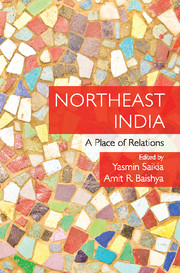Introduction
Published online by Cambridge University Press: 23 July 2017
Summary
‘Home’ but not at home
Sanjib Baruah in his book, Durable Disorder, recounts a curious tale of a man called Dindu Miri, a man ‘who came in from China’. Dindu was an Idu tribesman born in 1946 in what is now Arunachal Pradesh (Baruah, 2005: 55). In 1955, young Dindu went to Beijing to study. For the Idu, China and the Tibet region were closer to his village than any part of India. Dindu found employment as a ‘political interpreter’ and guided the Chinese in their advance to India during the Sino-Indian war. In 1963, Dindu, once again, returned to his village (now mapped in India). In 2000, Dindu worked as a political interpreter, but this time for the Indian government. The change of job did not mean an end of the relationship with his kin on the other side of the border, in China. The regime of rules between India and China, however, restricted easy communication and Dindu had to resort to ‘secret messengers’ to stay in touch with his relatives. Dindu's story is an unusual tale of a man caught in the liminal divide between nation-states, his life and emotions resembling two separated parts that do not constitute a whole (p. 56).
Purnakanta Buragohain's story parallels Dindu's tale. Buragohain, an Ahom entrepreneur and intrepid traveller sojourned for a decade through Burma and Yunnan province in Southern China during the interwar period, 1933–42. In his travels, over and over again, he found remnants of connections between the Tai communities inhabiting these regions and the Ahoms of Assam. In his travelogue, he recounts the cross-cultural connections between the people of Northeast India and Southeast and East Asia. In 1942, as the Japanese advanced into Burma, Buragohain fled on an elephant, in the process bringing back many valuable historical documents with him to Assam. In the post-war period, the gradual consolidation of the borders meant restriction of inter-state travel and Buragohain could not repeat his previous journey.
- Type
- Chapter
- Information
- Northeast IndiaA Place of Relations, pp. 1 - 24Publisher: Cambridge University PressPrint publication year: 2017

